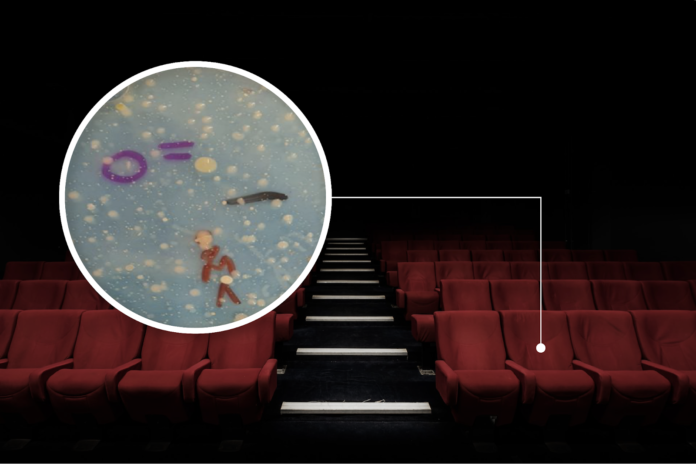Swab testing cinema seats and cup holders, a stomach-churning new study from Betway Casino reveals just how much bacteria is lurking in the dark at the movies.
- The average cinema seat houses 1,864 colonies of bacteria, which is a shocking 14 times more than on a normal toilet seat
- Cinema cup holders have 18 times more bacteria living in them than the average toilet seat
- Mould, mucus membrane, and infectious bacteria all found to be growing in cinema seats and cup holders
With film-lovers around the world eagerly anticipating the return of the Oscars in March, movie-fever is sweeping across the globe. Inspired by the latest batch of awards, plenty of us will be heading to the cinema over the next few months, but what else might we catch there apart from hit movies?
A stomach-churning new study from the team at Betway Casino has uncovered just how disgusting cinemas can be, revealing that thousands of bacteria colonies are living and growing in the dark. To find this out, they swabbed a range of cinema seats and cup holders, also swabbing toilet seats for comparison, before sending these off to a microbiology lab to be tested.
The average cinema seat houses almost TWO THOUSAND colonies of bacteria, which is 14 TIMES more than on a normal toilet seat
The shocking study found that there’s a huge 1,864 colonies of bacteria on a single cinema seat on average. In comparison, the average toilet houses around 135 colonies, which means cinema seats have a whopping 14 times the number of germs on them.
The dirtiest cinema seat tested had around 3,000 colonies of bacteria living on it which is around 22 times more bacteria than the average toilet seat. In comparison, the cleanest cinema seat had just 80 colonies of bacteria, though this is still only 55 colonies less than the average toilet.
Cinema cup holders have OVER TWO THOUSAND colonies of bacteria growing in them, 18 TIMES more bacteria than the average toilet seat
Somewhat surprisingly, the study also found that the average cinema cup holder contains even more germs than the seats — with around 2,396 colonies of bacteria living in one single cup holder on average. This equates to a huge 18 times more germs than a normal toilet.
On top of this, the dirtiest cup holder tested had more than 3,010 colonies of bacteria lurking inside. Plus, mould was even found in one of the cup holders swabbed – disgusting!
|
Location |
Average number of bacteria colonies |
|
Seat |
1,864 |
|
Cup |
2,396 |
|
Toilet seat |
135 |
Mould, mucus membrane, and infectious bacteria all found to be living in cinema seats and cup holders
From mucus membranes to mould, the research delved a little bit deeper to shine a light on the four main microbes that live in the cinema.
Staphylococcus spp and Micrococcus spp were found in all cinema seats tested in the experiment. These types of bacteria are found on human skin and mucus membranes, and are associated with skin shedding.
Bacillus spp was found in all cup holders tested in the study, and on several seats. Not commonly associated with disease, this type of bacteria is usually found in soil and water, however it can also live on human skin.
Pseudomonas spp was found to be living on several seats and cup holders. There are many different types of this bacteria, however it is Pseudomonas aeruginosa that mostly causes infections in humans.
You can avoid picking up any gross germs at the cinema by following basic hygiene practices such as sanitising your hands before eating and drinking anything, and making sure to wash your hands in soap and water as soon as you get home.
That being said, do these results make you feel queasy, and will you be more conscious of where you sit on your next trip to the movies?
Help keep news FREE for our readers
Supporting your local community newspaper/online news outlet is crucial now more than ever. If you believe in independent journalism, then consider making a valuable contribution by making a one-time or monthly donation. We operate in rural areas where providing unbiased news can be challenging. Read More About Supporting The West Wales Chronicle

























